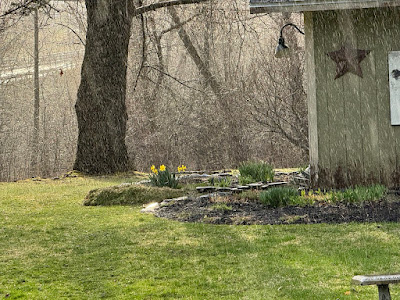 |
| Storm damage near Pittsburgh, PA on Tuesday. Severe storms caused lots of damage from Texas to New York, but spared us in Vermont. |
Sure enough, as expected, destructive weather struck in a broad band from Texas to New York.
Vermont once again escaped the rough storms, but the weather nonetheless got a little interesting in the Green Mountain state.
More on that in a bit.
NATIONAL STORMS
It seemed like the bad weather had plenty of targets on Tuesday.
Tornadoes and straight line winds of up to 100 mph, mixed with baseball sized hail in parts of central Texas, That must have been fun.
Winds were almost as strong near Springfield and Branson, Missouri with straight line winds of 91 mph, along with embedded tornadoes.
Lots of property damaged there, too.
A particularly intense band of storms originated in eastern Indiana, crossed southern Ohio and then through western and central Pennsylvania, causing all sorts of damage, with trees into homes and buildings, on cars and across roads and power lines.
The storm was particularly intense around Pittsburgh, with two storm-related deaths reported in the region. Winds gusted to 71.3 mph at the Pittsburgh airport, the third strongest wind gust on record there.
Roofs were torn off some Pittsburgh businesses and dozens of homes suffered damage when trees fell on them.
The storms blustered all the way into central and northern New York. Winds gusted to 77 mph in Rome, New York. Severe thunderstorm warnings blared as far north as Massena, in the northwest tip of the state.
Today, it looks like north Texas, including Dallas-Fort Worth, and parts of Oklahoma are at risk for tornadoes, severe storms and huge hailstones today.
Though severe storms and possible tornadoes are expected over the next few days over scattered parts of the U.S., any kind of immense new outbreak of tornadoes will likely wait until at least next week.
However, serious flooding, which has been a scourge since winter in parts of the Midwest, seems to be making a comeback this week.
Flooding has been hitting Oklahoma for days, and that will continue through today and at least tomorrow. At least two people have died in recent days in the flooding. A section of a major interstate highway in Oklahoma City was closed by flooding. Flash flood warnings were flashing through much of the state this morning.
Oklahoma City has had 11 inches of rain this month, compared to a normal of 3.5 inches.
Neighboring Arkansas, which has had severe floods this spring, is bracing for more.
VERMONT EFFECTS
 |
| The sky looked volatile as showers and thunderstorms approached St. Albans, Vermont Tuesday evening, but the storms were not severe. |
Burlington got to 83 degrees, just two degrees shy of the record for the date.
It was the first 80 degree reading of the year and the warmest it's been since September 18, 2024. Montpelier reached 82 degrees and Springfield, Vermont got to a toasty 86 degree.
As expected, the storms that eventually arrived from New York and into Vermont last evening weakened, though a few managed to stay fairly strong in northern Vermont, which again, was predicted.
A gusty storm with a torrential downpour blasted through St. Albans shortly after 10 p.m. The National Weather Service had warned that this storm could contain 50 mph winds. I don't see any reports of damage, though, so this wasn't severe.
The storms are over, skies are clearing and are temporary summer is definitely over. At least for awhile.
Today will feel completely different than Tuesday. The air will be fresh and cool, maybe even downright chilly in spots. A steady north wind will make it feel nippier, too.
The growing season has started in the Champlain Valley, so a frost advisory is up overnight and early Thursday in the Champlain Valley. Elsewhere in Vermont, it will be even colder than the Champlain Valley, with lows in the 20s in many spots far north. But the growing season isn't officially underway there, so no advisories.
The next storm system comes along Friday and, of course, Saturday. It's actually two storms. Neither will be that strong, but will spread showers our way.
The first one will arrive Thursday night and Friday. Friday will be warm and a bit humid, which means a couple thunderstorms might get thrown in. But they won't be severe.
It looks like a cold front will come through later Friday and a second storm will form along it and move northward for Saturday, which would give us our seventh rainy Saturday in a row. It's a little early to figure out exactly how Saturday will turn out, but the rain then looks more likely the further south and east you go in Vermont.
A potentially drier weather pattern could start next week. But that will be complicated by a stalled weather pattern. This stuck weather pattern looks like it will keep a storm spinning off the New England coast. It's unclear how close it will get to us.
Depending on what happens, next week could prove mild and sunny, or cool and showery. So that's no help. Stay tuned, I guess!



















